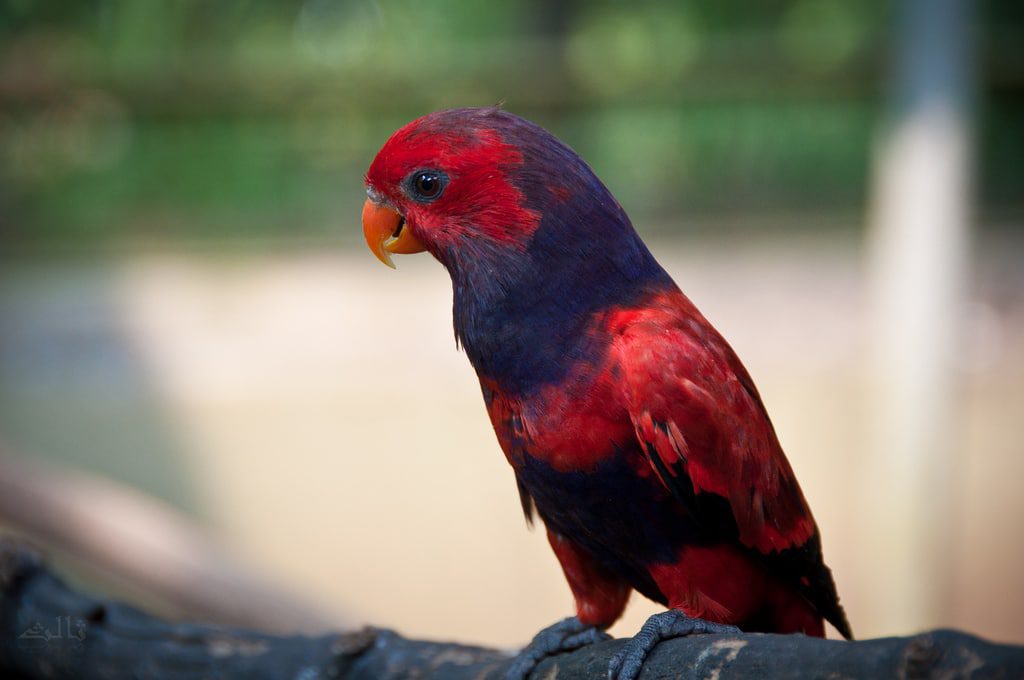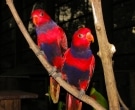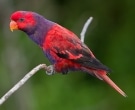Content |
|---|
Description
27 cm.. height and an approximate weight of 110 gr.
Along with the Red Lory (Eos Bornea) the “Violet-necked Lory” (Eos squamata) it is the only lory of the genus Eos it does not have blue marks on the ear-coverts.
Its plumage It has a scarlet general appearance. The neck It is surrounded by a violet blue collar which is well developed in some individuals, but nearly absent in others. The area from the abdomen up to the subcaudales it is dark purple. The scapulars they are dull purple with black tips. The feathers of the greater coverts and flight feather They are red with black tips.
The bottom of the wings and of remiges from below they are red with black spots at the primary level. The tail is purple red.
The irises is orange, the legs grey.
In the immature the feathers of the lower parts, have broad dull blackish purple borders. The irises They are brown.
- Sound of the Violet-necked Lory.
Description 3 subspecies
-
Eos squamata squamata
: (Boddaert, 1783) – Something smaller and feathers in the nominal species They are blue violet, in this subspecies are blackish blue.
-
Eos squamata riciniata
: (Bechstein, 1811) – Smaller and band chest and neck is violet gray.
-
Eos squamata obiensis
: (Rothschild, 1899) – It is somewhat smaller and with shoulders blacks. the band of neck It is variable and greyish violet. The area of the nape is red.
Habitat:
The Violet-necked Lory they are relatively common in the primeval forests or secondary forests that have large mature trees. Also found in the mountain forests and also, but with lower density in the coconut plantations bordering the coast, in the bushes during regeneration, in the abandoned gardens and mangroves.
Populations that inhabit small islands tend to stay near the coast.
On the larger islands, These birds can run in the forests of the mountains up to a height of 1.220 meters above the sea level.
The Violet-necked Lory they are particularly noisy and easily identifiable when they are in flocks, but they are a much more secretive behavior when in isolated pairs.
They usually gather in large flocks when they find abundant food sources.. This habit makes appearing more or less abundant in different regions. These flocks of birds are usually just above the tops of the trees.
Every day, they make short trips between the different islands. To do this they use a flight quick and direct, It consists of shallow wing beats. When they beat their wings produce a very audible hum.
Reproduction:
There is almost no information on the reproduction in the wild. In captivity, the implementation is of 2 eggs that are incubated during 27 days. As with all loris, the reproductive cycle is particularly long and hard about 80 days.
Food:
Exclusively vegetarian. They feed on sago palm in bloom and consume figs when they are still firm. Also eat nectar from big red flowers of Erythrina family Fabaceae.
Distribution:
Size of its range (reproduction / resident): 189.000 km2
The Violet-necked Lory They are endemic to the islands or archipelagos which are among New Guinea and Las Celebes.
They are mostly found in West Papua and of the Moluccan Islands.
Distribution 3 subspecies
-
Eos squamata squamata
: (Boddaert, 1783) – Islands West Papua, that is to say Stupid, Waigeo, Batanta and Misool and islas Turtle (Indonesian)
-
Eos squamata riciniata
: (Bechstein, 1811) – North of Moluccas, from Morotai to Bacan and Damar, also in islas Widi and Mayu islands in the sea of Moluccas (Indonesian).
-
Eos squamata obiensis
: (Rothschild, 1899) – Only in the Obi Islands in the northern Moluccas.
Conservation:
• Current IUCN Red List category: Least concern
• Population trend: Stable
The population size is very large, and therefore not approaching the threshold of Vulnerable under the criterion of population size.
The world population is estimated between 100,000 and 500,000 individuals.
About 3.000 specimens are caught every year for the trade aviaries. The pressure on the species is estimated to be quite reasonable, but it is recommended, by many associations, the establishment of catch quotas for the year.
"Violet-necked Lory" in captivity:
Son loving, curious, extroverts and show some unique behaviors. Some like to wrap yourself in a blanket to sleep. Sometimes, they can even be sleeping on your back. They can learn to mimic sounds and words.
They are capable of aggressive behavior if their territories and possessions is disregarded.
They are demanding in the requirements should be for their care, requiring much attention. Baths or showers daily should be part of your daily habit.
Alternative names:
– Violet-necked Lory, Moluccan Red Lory, Violet necked Lory (ingles).
– Lori écaillé, Lori à nuque violette, Lori de Wallace (French).
– Kapuzenlori (German).
– Lóris-de-colar-violeta (Portuguese).
– Lori de Collar Violeta, Lori Escamosa, Lori Escamoso (español).
scientific classification:
– Order: Psittaciformes
– Family: Psittaculidae
– Scientific name: Eos squamata
– Genus: Eos
– Citation: (Boddaert, 1783)
– Protonimo: Psittacus Squamatus
Images “Violet-necked Lory”:
Videos "Violet-necked Lory"
————————————————————————————————–
“Violet-necked Lory” (Eos squamata)
Sources:
– Avibase, BirdLife.org, Oiseaux.NET
– Photos: SALIS- (Flickr), Bernard DUPONT (Flickr), Wikimedia, IBC.lynxeds.com
– Sounds: Frank Lambert (Xeno-canto)






